Beyond the prison walls: reforming through silence
Ajit Kumar Bohet & Toolika Wadhwa
As part of jail reforms, Vipassana camps are organized inside the prison walls of Tihar Jail, New Delhi. Being a central jail, Tihar Jail is a host to inmates arrested for crimes ranging from petty theft and robbery to heinous crimes likes rape, murder and the like. The present study was focused upon understanding how experiential meditation in Vipassana helps its heterogeneous group of inmates to attain peace of mind, deal with their emotions related to crime and reconstruct their identities based on hope. A group of research scholars from Central Institute of Education, University of Delhi1 interacted with the jail inmates in order to understand and document the experiences of practicing inmates. “Beyond the Prison Walls: Reforming through Silence” presents the beliefs, experiences and practices of these inmates.
About Tihar Jail
The Tihar Jail Complex in New Delhi is one of the largest prison complexes in the world. It comprises of nine prisons with a total population of around 13,000 prisoners against a sanctioned capacity of 4800 prisoners and one District Jail at Rohini with a total Population of around 1800 prisoners against a sanctioned capacity of 1050 prisoners. A vast majority of prisoners at Tihar are under trials.
Recognising the importance of self-development for inmates, several welfare activities were started at Tihar Jail as part of prison reforms. These activities include learning carpentry, electrical work, food processing (making namkeen mixtures, biscuits etc,), making folders, photo frames etc. One of the purposes of the activities is providing prisoners alternative occupations they might pursue once outside jail. These, along with recreational activities like celebrating festivals, games and sports (badminton, football, cricket, chess, ludo etc.), gardening, painting, reading etc. also help prisoners to channelise their energies towards meaningful tasks. Besides these, inmates are encouraged to read in the library and pursue courses through distance learning mode. Camps of spiritual practices such as Raja Yoga, Art of Living, Vipassana etc. also help inmates to reflect on their lives and reformulate their sense of self. Such practices provide inmates another chance to reflect upon and reconstruct their life scripts, reformulate a new sense of identity, accept jail life and gain attain peace within. Welfare and reformation practices also help prisoners cope with crime, jail and resultant emotional turmoil. At the same time, it helps them to discover their own potentials, providing hope for the future.
Vipassana in prisons
Vipassana is a meditative technique that helps establish peace of mind. It is a method of self-observation/ introspection that calms the conscious. The method emphasizes on leading a balanced life through achieving patience, purity of mind and peace. Vipassana is a technique of cleansing the mind disturbed by enmity and attachment. It is an active method of making life tension free.
The technique has been adopted in several prisons across India. In the history of Indian police, the first ever Vipassana camp was held in Central Jail, Jaipur in the year 1975. About 120 prison inmates participated in the camp. The camp was followed by camps in Rajasthan Police Academy, Jaipur (1976); Central Jail, Jaipur (1977); Sabaramati Central Jail, Ahmedabad (1991) and Central Jail, Baroda (1992). The camps showed positive and meaningful results.
In 1993, Kiran Bedi, a reformist Inspector General of India's prison learned of the success of using Vipassan? in a jail in Jaipur, Rajasthan and decided to make another attempt in India's largest prison, Tihar Jail, New Delhi. This program was said to have dramatically changed the behaviour of inmates and jailers alike. It was actually found that inmates who completed the 10 day course were less violent and had a lower recidivism rate than other inmates. It was introduced in Tihar by Ms. Kiran Bedi as part of humanistic jail reforms at the behest of Rajinder Singh, a jail official and Vipassana practitioner. The first Vipassana camp in Central Jail, Delhi was held on 22 November 1993 in Jail 2. In April 1994, Shri Goenka himself organized a Vipassana Camp in which over 1100 jail officials, prison staff and inmates participated. In April, 1994 itself, Shri Goenka himself formally inaugurated a permanent Vipassana Center, “Dhamma” in Jail No. 4 at Tihar Jail. Since then it has been continually in practice as a “Sadhna Kendra.”
Vipassana for prison officials
The Vipassana Training course was first introduced at the Delhi Police Training College at Jharoda Kalan in January 1999. The aim of the exercise was to help police personnel learn to “police” themselves before teaching others. In this 13 day camp (from 1st to 12th January 1999), around 32 (31 male and 1 female) personnel (including 1 HCP, 3 DCPs, 1 ACP, 12 Inspectors, 7 SIs, 2 HCs and 6 CTs) participated. The success of the camp can be estimated by the fact that the second camp followed after merely 3 months (5-16th March 1999). Around 1021 (1018 male and 3 female) police personnel participated (including 1 DCP, 1 ACP, 10 Inspectors, 38 Sub-Inspectors, 11 ASIs and 760 CTs). By June 2002, 24 camps had been organized in Delhi Police Training Colleges from which 3776 people (3581 male and 195 female) had benefited.
What is Vipassana?
Vipassan? meditation consists of the experiential observation of mind and matter (n?ma and r?pa) in their aspects of impermanence, dissatisfaction and lack of an inherent, independent essence or self. To see through the mode of impermanence means to examine things as to whether they are permanent. To see through the mode of dissatisfaction means to examine things as to whether they are satisfactory or are imbued with suffering. To see through the mode of non-self means to examine the phenomena that are the objects of the meditation to see if they have a permanent, isolated, and enduring entity. In other words, to see through non-self relates to having a sense of non-doership and a sense of non-possessiveness while examining things.
The foundation of Vipassana meditation is “s?la—moral conduct”. The practice is strengthened through “sam?dhi—concentration of the mind”. And the purification of the mental processes is achieved through “paññ?—the wisdom of insight.” Vipassana meditation is the purification of the mind. It is the highest form of awareness—the total perception of the mind-matter phenomena in its true nature. It is the observation of things as they are.
Through Vipassana anyone, irrespective of race, caste, or creed, can eliminate those tendencies that have woven so much anger, passion, and fear into our lives.
The ten-day course
“Students wishing to learn Vipassana meditation undergo a minimum ten-day course, during which time they take precepts not to kill, not to steal, not to commit sexual misconduct, not to speak lies, and to refrain from intoxicants. For the entire ten days they live within the course site. Each day begins at 4:30 a.m. and continues until 9:00 p.m., with the student aiming for at least ten hours of meditation (with breaks). For three days the student develops concentration of the mind by observing the inhalation and exhalation of the breath (Anapana). During the ensuing days the student develops awareness and equanimity towards the various sensations experienced within the framework of the body and is shown how to penetrate his entire physical and mental makeup with the clarity of insight (Vipassana). Each day’s progress is explained during an hour-long discourse in the evening. The course closes on the last day with the practice of loving kindness meditation (mett? bh?van?), the sharing of the purity developed during the course with all beings.”1
The project at hand…
A team of research scholars at the Department of Education [Central Institute of Education, University of Delhi] undertook the present study under the guidance of Dr. Namita Ranganathan. The aims of the study were as follows-
- To develop an understanding of the needs of Tihar inmates which drive them towards Vipassana
- To know the Perceptions and Experiences of the convicts and under trials who had attended Vipassana camps about Vipassana
- To identify its effects on their mental, socia1 and physical well being
- To find out how Vipassana practice helps them deal with life in jail; their emotions and feelings related to the crime committed by them and thoughts about their future life.
- To identify their practice patterns post Vipassana camps
Research methodology
The fieldwork was spaced out over 6 months in which four visits were made to the Tihar Jail complex. Jail No. 4 was visited thrice and one visit was made to Jail No. 2. The project fieldwork included group discussions, informal interviews and focus group discussions spaced over the four visits made. Twenty research scholars from Central Institute of Education, University of Delhi (including Dr. Ranganathan, Reader, C.I.E., D.U.) visited Tihar Jail. Not all however, were present in all four visits.
Before the first visit, research scholars were given an introduction to Vipassana through a video presentation followed by a discussion. Several meetings were also conducted by the research scholars to develop tools for research before making the first visit. It was collectively decided that semi-structured, informal interviews of each inmate will be taken together by a pair of researchers. After the initial visits, interviews were also taken immediately by the researchers. Three tools, one each for inmates, officials and Vipassana trainers, were developed. Some of the areas on which questions were developed are as follows:
- Inmates
- Background of the inmate interviewed- biographical details, crime etc.
- Daily routine in prison
- Reforms at Tihar Jail
- Vipassana camps- no. of camps attended, expectations from the camp etc.
- Routine in camp, experiences at the camp
- Changes post vipassana, practicing outside the camp, reactions of inmates etc.
- Officials
- Biographical details- including term of duty at Tihar Jail, attending Vipassana camps etc.
- Reforms in Tihar Jail
- Changes observed in prisoners post Vipassana
- Vipassana Trainers
- Background and biographical information
- Concept of Vipassana
- Experiences of conducting the camps in prisons- problems faced, special moments shared etc.
- Benefits to prisoners
Since the interviews were semi-structured, the researchers were allowed to modify, delete or add questions.
The rules at Tihar Jail did not allow any recording instruments except pen and paper. Working in pairs therefore, facilitated preparing written records of interviews conducted. After each visit, each researcher prepared detailed field notes including his/her observations and experience of the visit. A group discussion was also conducted in the first meeting at the Tihar Jail complex itself. All research scholars discussed the infrastructure of Tihar Jail and the life of inmates at Tihar freely with several Tihar Jail officials.
In the last visit, a focus group discussion with the inmates was also conducted by Dr. Ranganathan. The inmates were encouraged to share their experience of Vipassana and life in jail post Vipassana camp.
Data analysis
The present section presents an analysis of the field notes recorded on the bases of data collected through in depth interviews of inmates, questionnaire, team meetings with jail officials, informal conversations with them during lunch and tea sessions and on going comments. Since the interviews were conversational and thematic in nature, many additional questions were developed spontaneously from the immediate context.
Analysis of profiles of inmates
An analysis of the profiles of the inmates interviewed on four bases is presented in the following charts:
Age
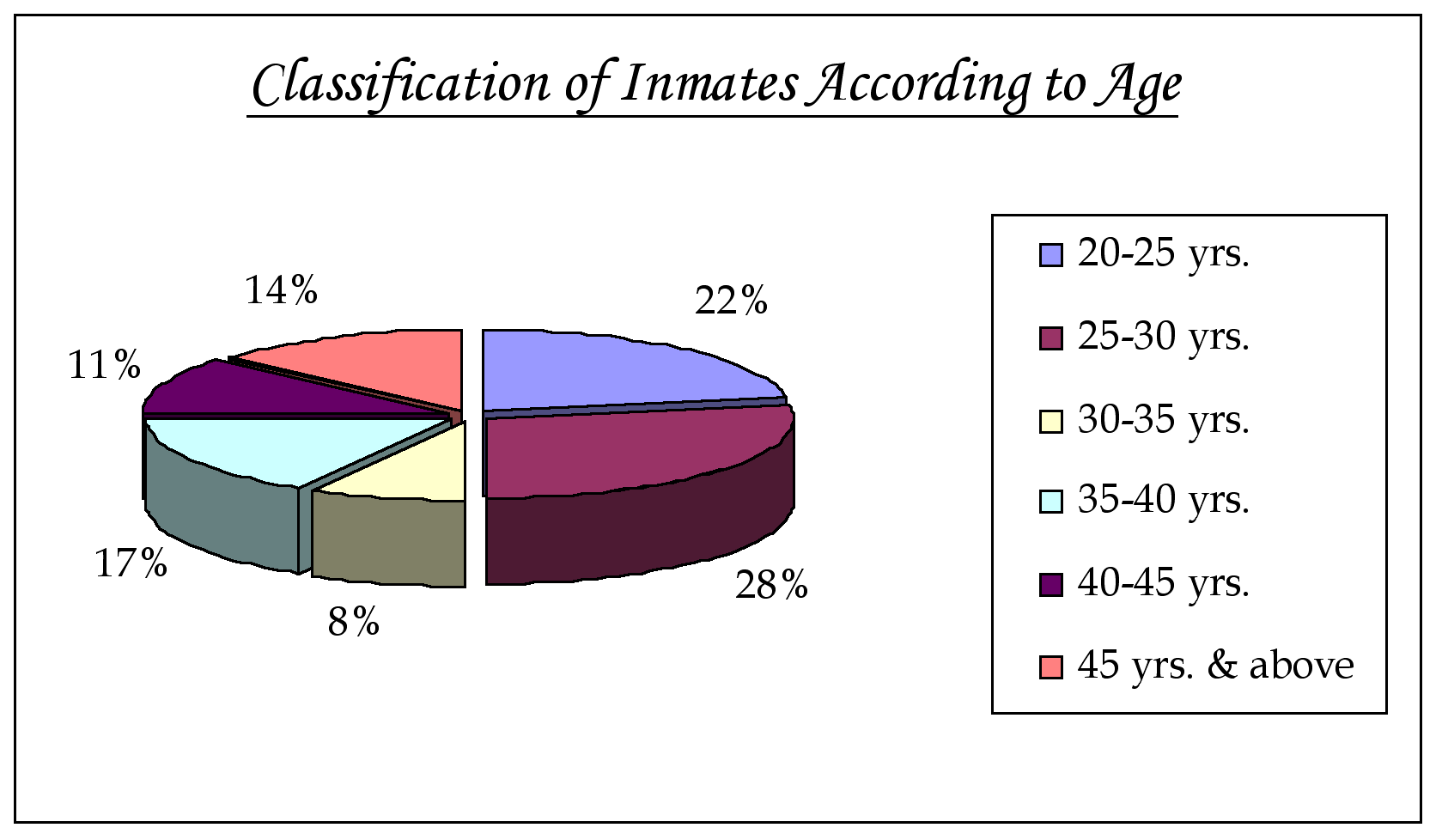
Nature of Crime

Time in Jail
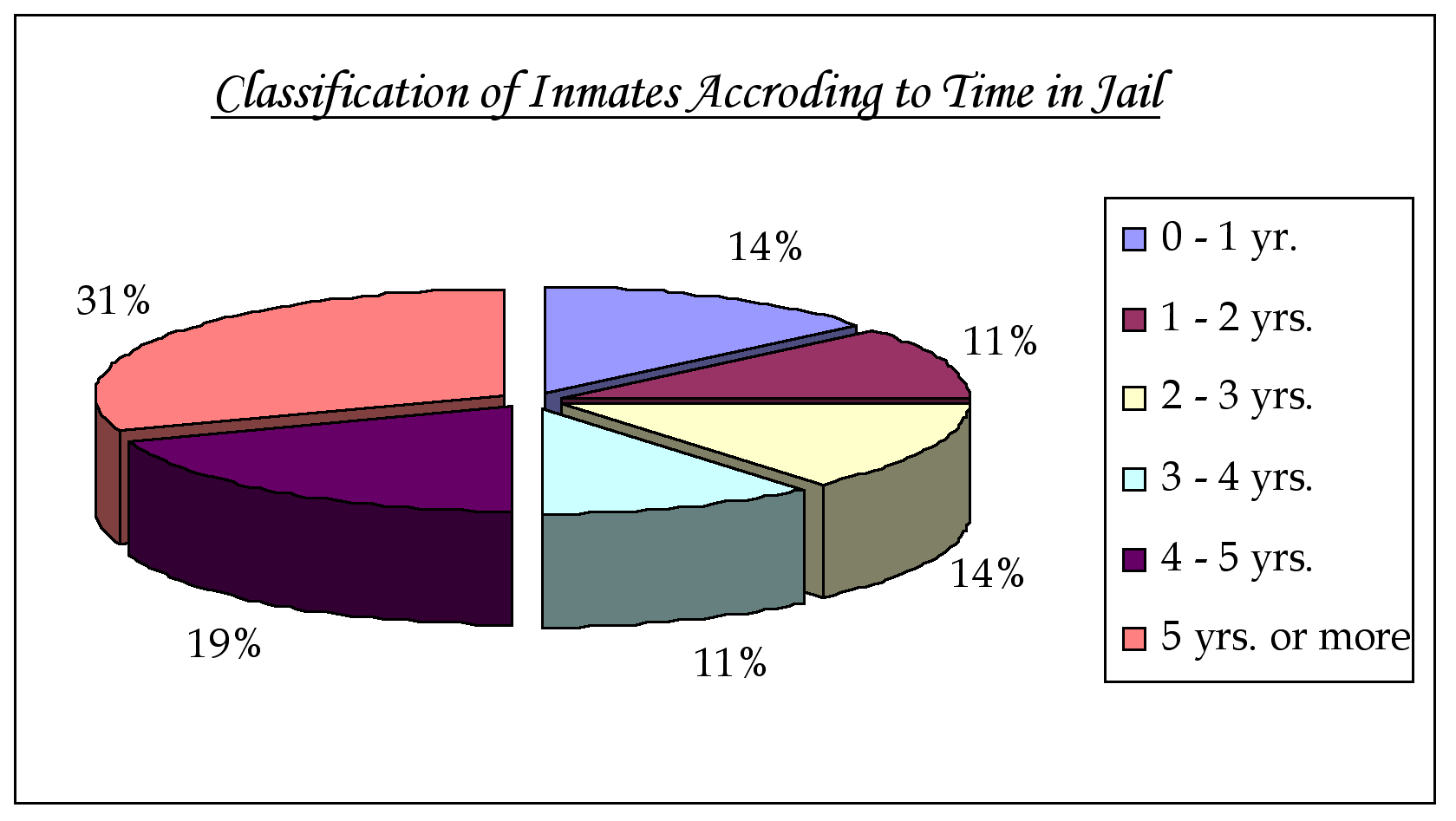
Number of Vipassana Camps attended
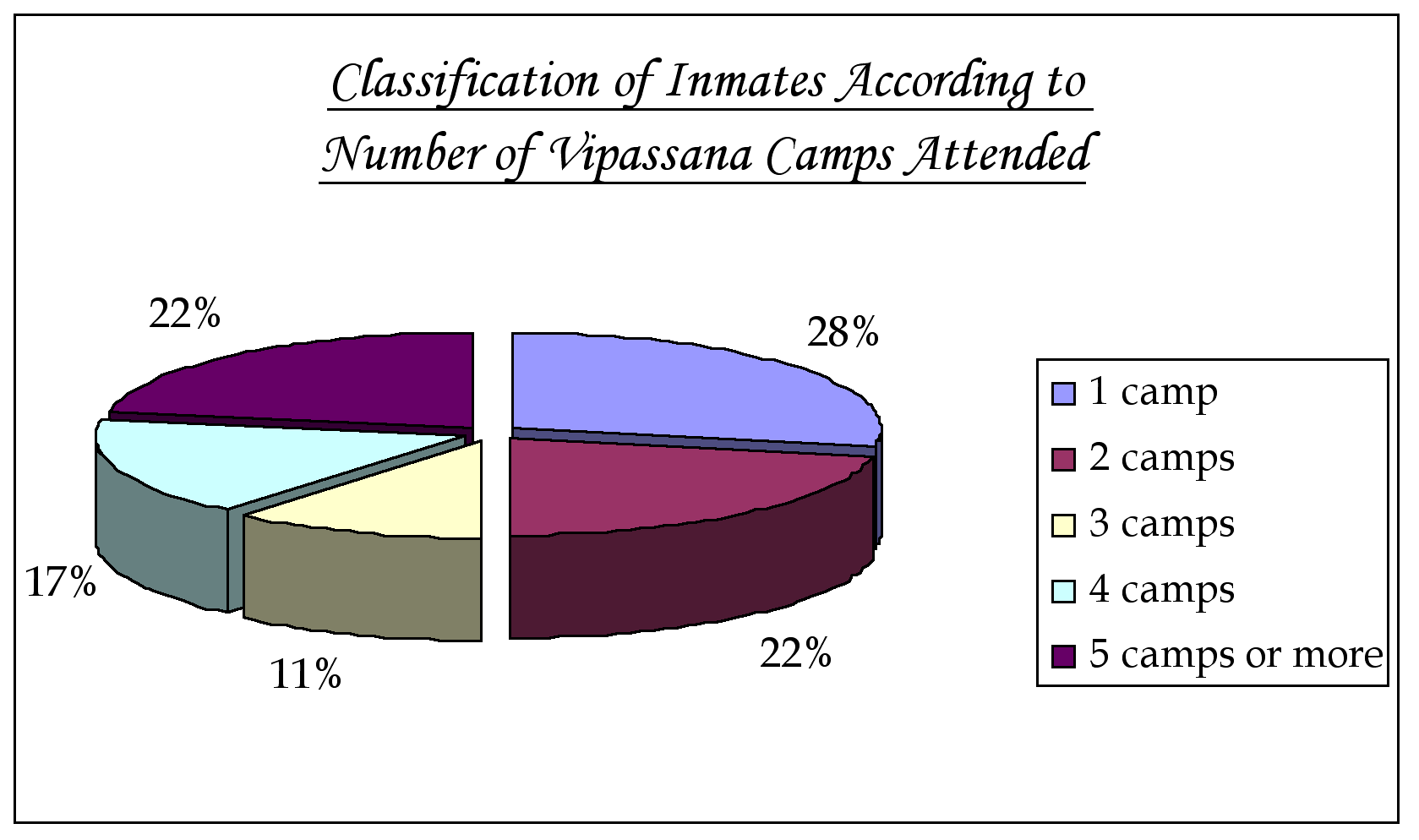
Analysis of Interviews with Inmates
In-depth interviews with approximately forty inmates were analysed on 3 main themes-
- Vipassana: as understood by Tihar Inmates
- Benefits of Vipassana
- Post Camp Vipassana Practice
The following sub-sections present data analysis on these themes. Each analysis is also presented graphically. The analysis also includes excerpts from researchers’ field notes based on observations and conversations with inmates and officials during the four visits.
Vipassana: as understood by Tihar inmates
The inmates were asked to narrate their own perceptions about the technique of Vipassana. Around 19% of those interviewed said that Vipassana teaches how to gain control over one’s mind. 14% agreed that it teaching control over breathing and 6% said that it helps attain Purity of breath and mind. Around 17% said that Vipassana is a secular practice; therefore people from any religion can practice it without letting go of their own religion. 3% of the inmates interviewed found Vipassana to be better than other spiritual practices they had adopted.
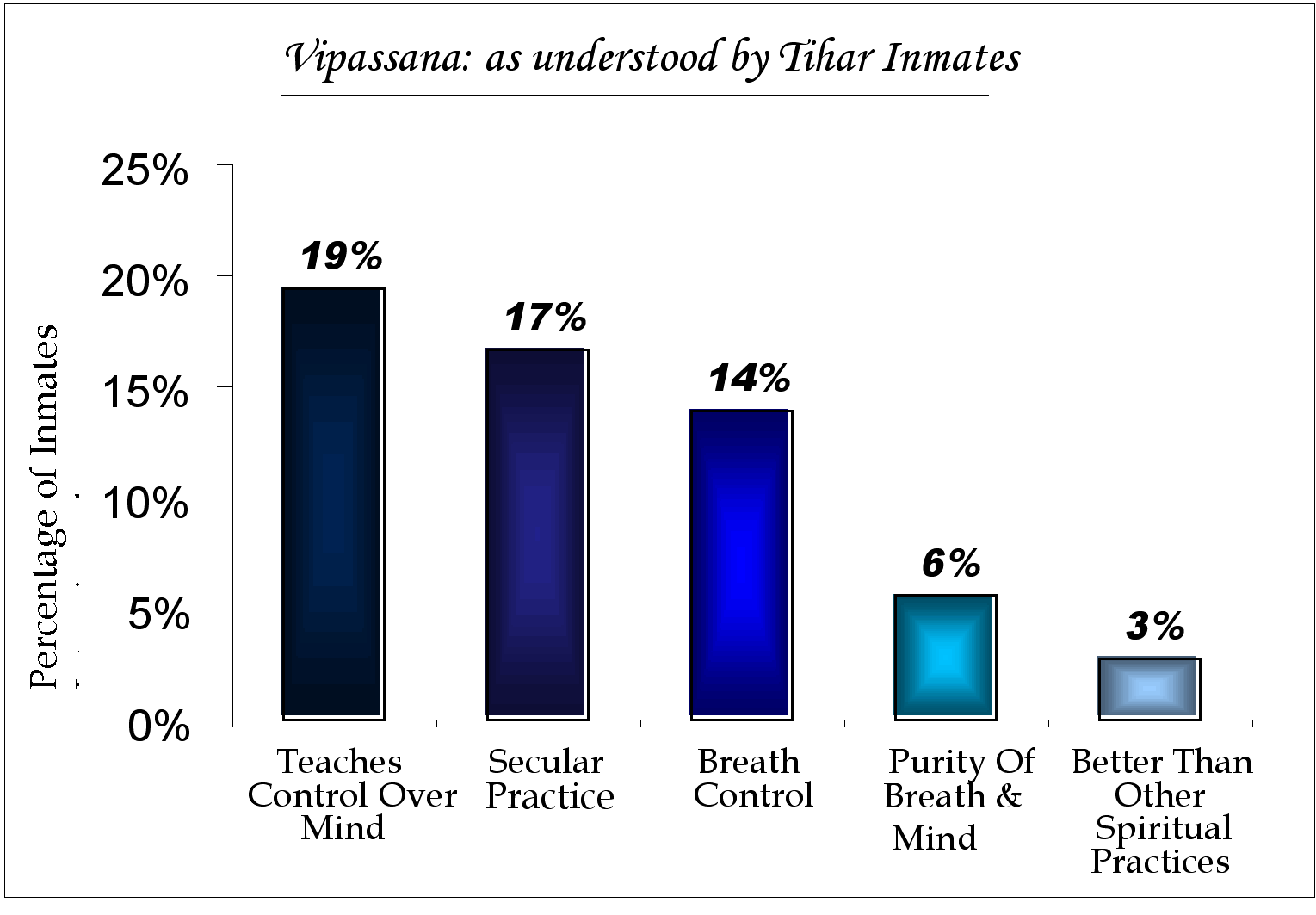
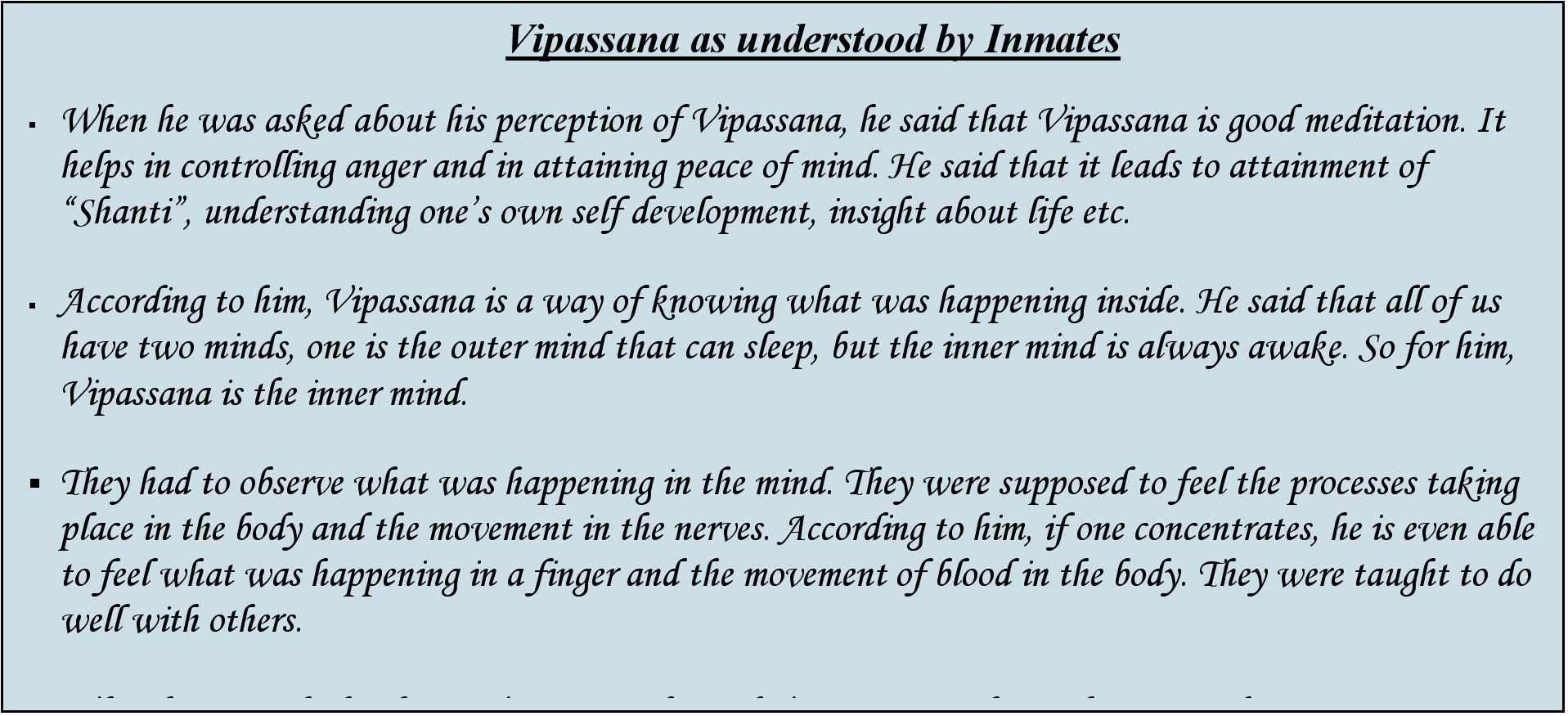
Benefits of Vipassana
Majority of the inmates reported that Vipassana helps in attaining peace of mind and in controlling anger. Over forty percent reported that it helps them to deal with evil thoughts and not to act on them. About a similar percentage reported that Vipassana helped them to better adjust with life in jail and filled them with a sense of optimism towards the future. Inmates also reported that Vipassana helped them to manage stress, deal with thoughts about the crime they had committed and with feelings of homesickness. A few inmates also said that it helped them to come over drug and substance abuse. Inmates also reported that Vipassana helped them to understand themselves better and realize their own potentials at the same time helping them find happiness in themselves. Vipassana also helped them develop positive thoughts about others around them.
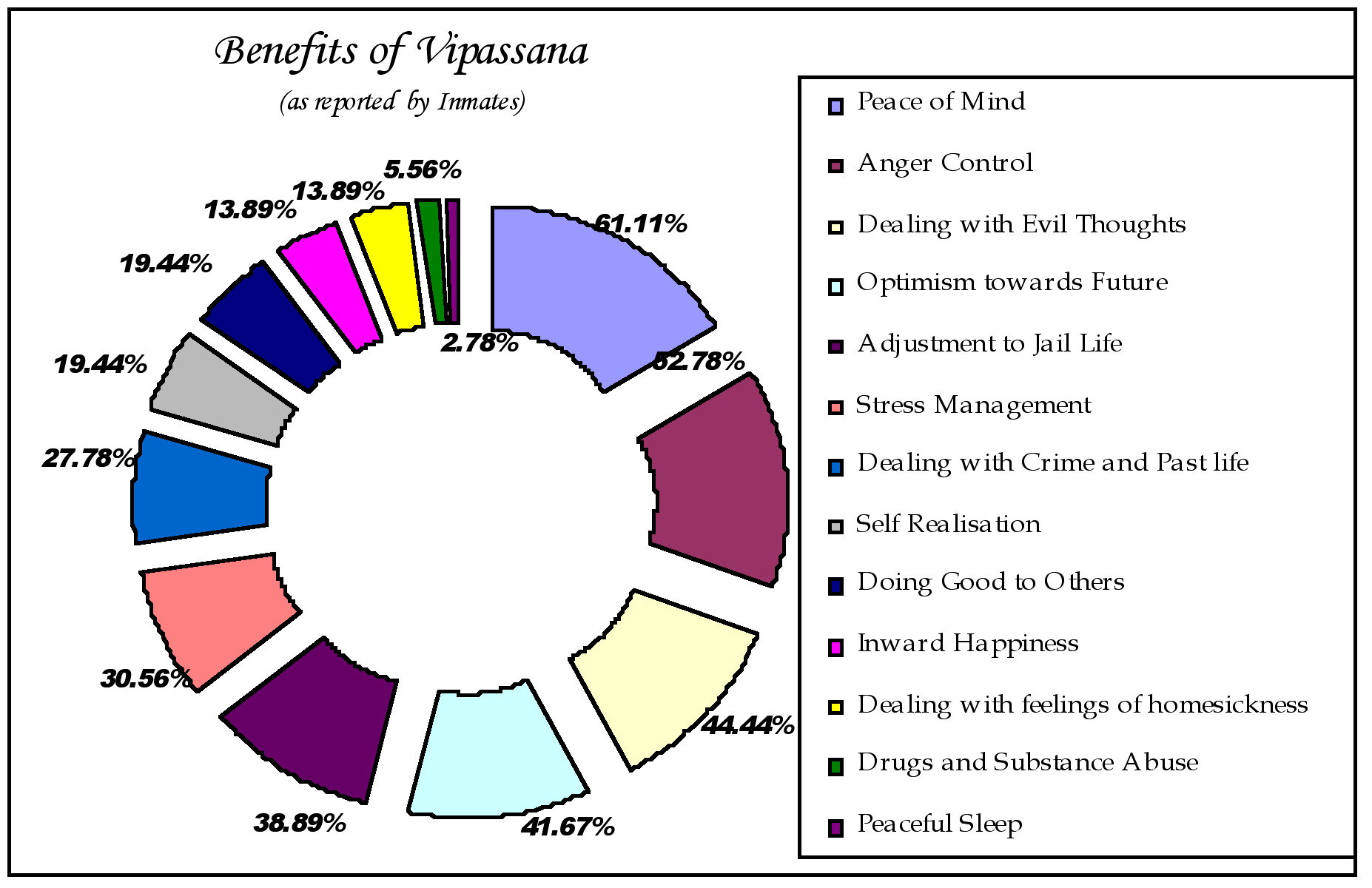
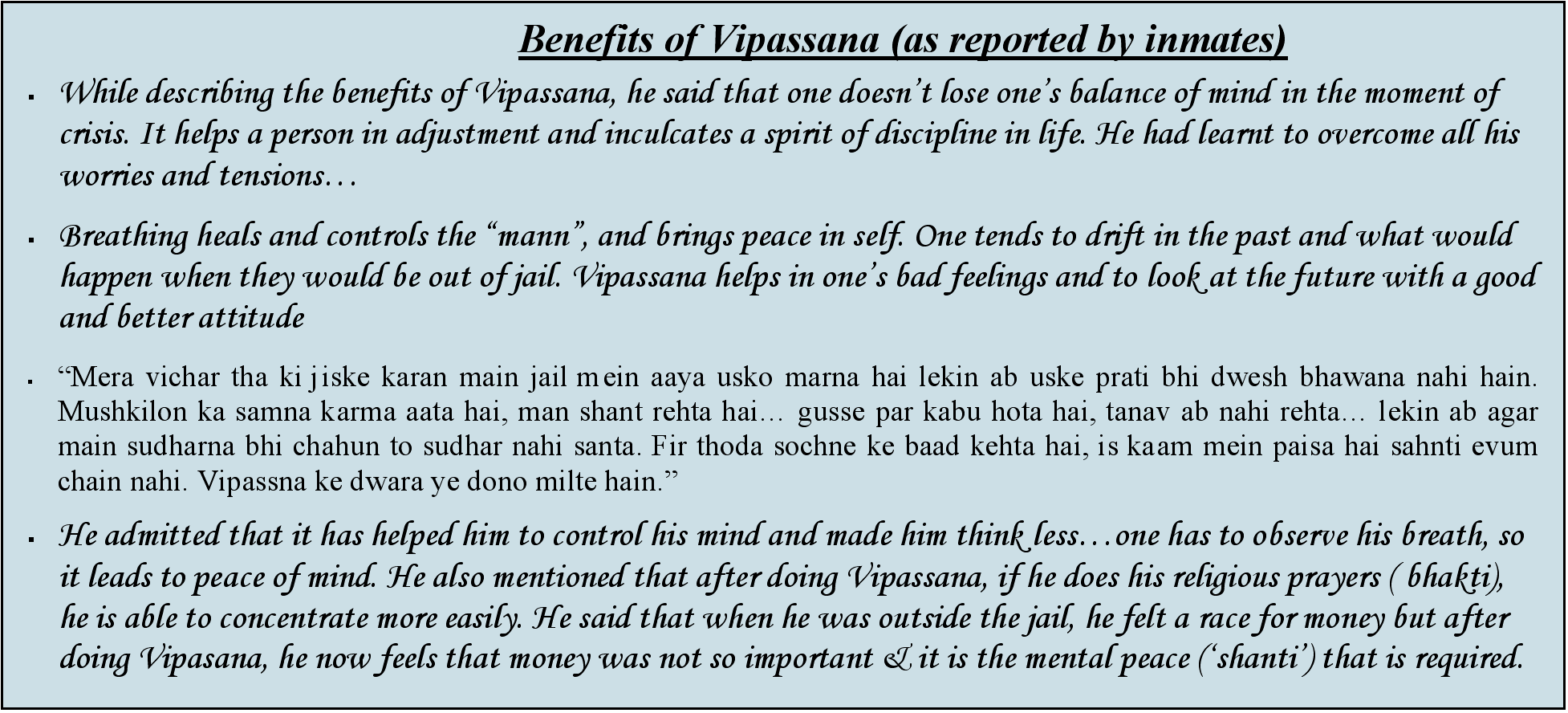
Post camp Vipassana practice
More than one-third of the inmates interviewed reported that they practice regularly in their wards. About one-tenth of the inmates also said that they faced difficulty in practice because of the noise & disturbances in the jail wards. Only 3% reported that they did not practice Vipassana after the camps they had attended.
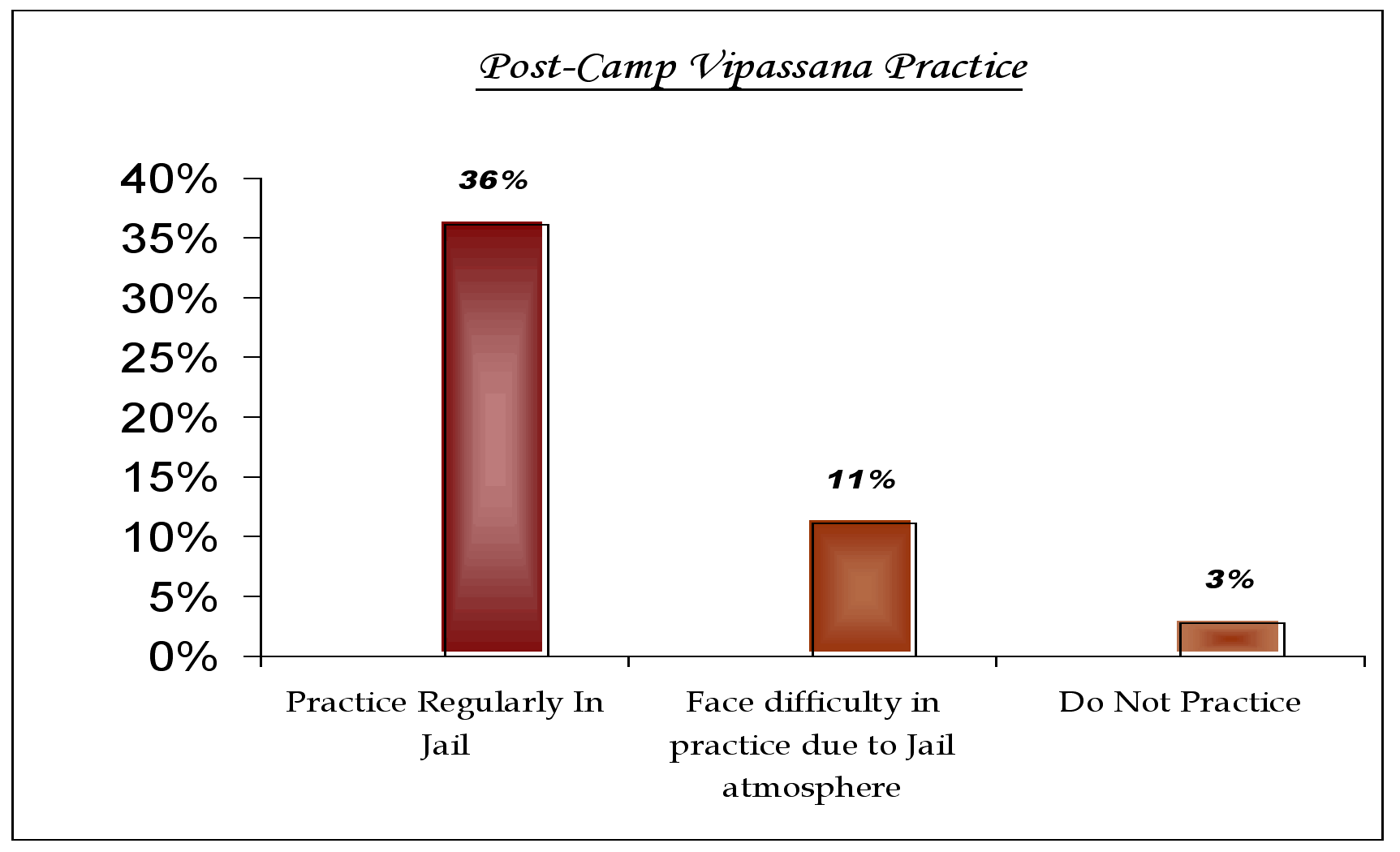

Analysis of the focus group discussion
The topic of the focus group discussion with the Tihar Jail inmates was the impact of Vipassana on life behind the prison walls. Inmates were allowed to interact freely with each other and the researcher. The researchers found that Vipassana enabled them to strike a balance in life and establish peace with themselves. They no longer felt extreme emotions and were able to maintain an even control over their feelings. The camp helped them develop a new sense of optimism and they started viewing the jail term as an interim phase of their lives. It also helped them cope with feelings of guilt, allowing them to forgive themselves. They accept their crime but no longer view themselves as labeled sinners for life.
The most significant part of the focus group discussion was the heterogeneity of the group. People from different regions, age groups and socio-economic status participated in the focus group discussion. The presence of lawyers, stock brokers, taxi drivers and the jobless allowed arriving at an understanding that cut across various class levels.
Experiencing Vipassana
At the beginning of the report, Vipassana has been described as an experiential observation technique. Since it is “experiential” by its very nature, any research on Vipassana would be incomplete if it fails to capture the experiences of the practitioners. The present section briefly presents the experiences of some of the inmates interviewed during research. (Names have been changed to protect their identity.)
Mahavir Prasad is a middle aged man who has spent 8 years in Tihar for attempting to murder his wife. He has attended over 27 Vipassana camps, 13 Art of Living courses and regular listens to tapes of Raja Yoga. Vipassana, he claims, taught him that if one does good to others, he gets benefited in return. He strongly believed in Guru ji’s saying that “Saans hi shabd hai.. if breath is pure then one will do no wrong and only good. On the contrary, if one’s breath is foul then only foul words will come out.” Mahavir Prasad was always spiritual. He strongly believes that through Vipassana one can accomplish the impossible and achieve even the most difficult aim in one’s life.
Salim is of Pakistani origin and was arrested for illegal immigration. In the nearly 3 years that he has spent in Tihar, Salim has attended 2 Vipassana camps. Initially, he was apprehensive thinking that Vipassana was a Hindu dominated religious practice. He accepted that he was surprised by the secularity of the camp. He has learnt the 5 dictums of Vipassana:- i) abstinence from lies; ii) maintenance of silence; iii)prohibition on taking drugs; iv)control over one's anger and v)strength to forgive others and not letting negative evil thoughts enter one’s mind
24 year old Dinesh Chand has just enrolled for his second Vipassana camp. A friend in jail aroused his curiosity about the practice. Changes post Vipassana that he perceived in himself include becoming less quarrelsome, more patient and tolerant towards people. Initially when he came to the jail he used to feel very restless and couldn't sleep properly, but post Vipassana he does his sadhana and meditates regularly in the morning and evening which gives him a feeling of shanti and calmness and he helps him sleep better.
Lawyer, Ashish Kumar, has been under trial for the last 4 years. Belonging to an affluent family, Ashish has attended 4 Vipassana camps. He cited attainment of shanti, equanimity, understanding one's own self, and development of insights about life as benefits of Vipassana. He realised that nothing in life is permanent, everything is in transition, and even the time in jail is a transitory period. Initially worries about his family used to occupy his thoughts but Vipassana has helped him to overcome this as well. He is now more detached in his attitude.
Arun has been in jail since 2004 for a case of dowry death. At the age of 30, Arun regularly practices Vipassana, Art of Living and Pranayam. Post Vipassana, His stirred up and racing mind felt very calm. He could focus on his breathing and learnt to control anger and tension. He has learn to accept the realities of life. He always feared the stigma attached to being in jail but Vipassana is helping him to deal with his fear. Vipassana has also helped him to resist provocation to get angry and retaliate.
John was arrested 2 years ago in a Narcotics case. Now 47, he regularly practices Vipassana. He says Vipassana has regenerated his youthfulness and helped him in anger management. He said jail staff must also take up Vipassana to change their attitude towards inmates. When asked on how Vipassana has benefited him, he said- “I am feeling very light and spiritually calm.”
Researchers’ observations
The first time we went to Tihar Jail, each one of us had his or her own set of images both of the inmates and of the Jail itself. However, when we went there, most of us had a shift in perspectives. We realized that the inmates were just as human as each one of us. Branding them as criminals for life was therefore incorrect. Each one of us was also able to develop a perspective of life inside the four walls. We understood the improvements brought about by the jail reforms but we were also able to develop a sense of the complexities of life of prisoners.
Talking to officials, we developed an understanding of how things were changing in the Tihar complex. Working on humanitarian principles, jail officials were changing the way they themselves looked at the inmates. Nevertheless, while talking to inmates we were able to grasp that corruption and malpractice were still not entirely wiped out from the face of Tihar. One inmates said “Jail mein amir aadmi ki mauj hai. Woh paisa deta hai isliye kuch kaam nahi karta. 8 baje so ke uthta hai. Gareeb aadmi ko dikat hoti hai” Another inmate spoke of how cigarettes found their way inside the complex, sometimes even with the help of officials. At times the researchers felt that the officials were presenting a very rosy picture of their behaviour towards the inmates which was far from reality. The officials presented one side of the story. The inmates gave us a more rounded picture. While some of them expressed unhappiness over the way the judicial and the law and order system of the country worked. Others were dismayed by the heartless attitude of the officials. Some were distraught by the quality of life in Tihar. Some were so distraught by the quality of food that they undertook Vipassana just to ensure that they get good quality food. Problems of food quantity, food quality, over crowding in barracks, inability to meet family members– all added to the discomfort of life at Tihar. Not all prisoners, though, spoke against the system. Some of the prisoners however expressed contentment with the way things were; adding that what they were getting was more than they (their deeds) deserved. A majority of the inmates interviewed expressed the need for prison officials to undertake Vipassana themselves. They even quoted examples of the changes they had observed in the jail officials who had attended Vipassana camps.
Findings of the study
All inmates reported benefiting from Vipassana camps. It may be noted that a good number of inmates reported that Vipassana camps help practitioners establish peace of mind and exercise control over their anger. It was also noted that Vipassana has helped inmates develop a positive outlook towards life, have faith in their own selves and develop optimism towards future life.
A research study conducted in 1998 by Kishore Chandiramani, S. K. Verma and Prof P. L. Dhar on the “Psychological Effects of Vipassana on Tihar Jail Inmates” reported similar findings:
The statistical analysis of the results has revealed significant improvement in the functioning of inmates following Vipassana on most psychological parameters studied. There is a considerable reduction in the neurotic predisposition and in the feelings of hostility, helplessness and anomie, while the sense of hope and well being are enhanced.2
Another study conducted by Dr. Khurana and Prof. Dhar in June, 2000 showed that level of “Criminal Propensity” is reduced and that of “Subjective Well-being” increased after practicing Vipassana, among female inmates.3
The two studies quoted above clearly indicate that Vipassana is beneficial for the inmates of Tihar Jail. Both the studies used structured questionnaires and statistical techniques to arrive at the conclusion. The present study on the other hand has focused on the qualitative aspect of the benefits of Vipassana. An effort has been made to understand and appreciate the experiences of the Tihar inmates. The role played by Vipassana in the lives of the inmates, in the camp and outside, has also been understood from the perspective of the inmates themselves.
Based on the present study and the two studies quoted above, it may be concluded that attending Vipassana camps and practicing Vipassana brings a qualitative improvement in the life of the inmates.
Suggestions and recommendations
- Keeping in mind the reforms being made at Tihar, the concept and name of the place should be changed from “Tihar Jail” to “Tihar Reform Centre”.
- Vipassana camps should be regularly organized in the “Tihar Reform Centre”.
- Efforts should be made to encourage and increasing number of inmates to attend Vipassana Camps.
- Vipassana practitioners in every Jail should be provided separate wards to practice Vipassana.
- Efforts should be made to introduce Vipassana in other prisons across the country.
- Police personnel should also be encouraged to attend Vipassana camps to develop a more humane attitude towards inmates.
- Further research
- The present study may be extended to a case wise examination of the benefits of Vipassana on select inmates.
- Similar studies may be conducted in Women’s and Adolescents’ wards.
Further research
- The present study may be extended to a case wise examination of the benefits of Vipassana on select inmates.
- Similar studies may be conducted in Women’s and Adolescents’ wards.
References
extract from : www.vri.dhamma.org
“Psychological Effects of Vipassana on Tihar Jail Inmates” by Kishore Chandiramani, S. K. Verma and Prof P. L. Dhar – 1998
“Effect of Vipassana Meditation on Quality of life, Subjective well-being, and Criminal Propensity among inmates of Tihar jail, Delhi” by Dr Amulya Khurana and Prof. P. L. Dhar, June 2000
